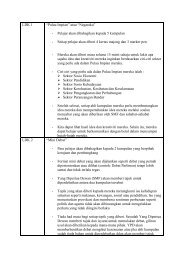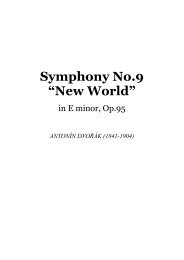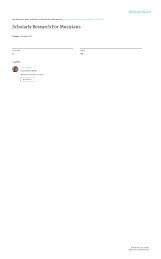APSMER2017 PROCEEDINGS
Create successful ePaper yourself
Turn your PDF publications into a flip-book with our unique Google optimized e-Paper software.
Proceedings of the 11th Asia-Pacific Symposium for Music Education Research<br />
(APSMER 2017) 19th to 21st July 2017, Melaka MALAYSIA<br />
rhythmic, are distributed evenly between each part. In the present version for<br />
a Western classical ensemble (flute, viola and piano), all of the instruments<br />
perform the melodic lines which include stylistic ornamentations, in addition<br />
to their rhythmic, harmonic, and counter-melodic functions.<br />
The structure of this piece is consistent with the standard form of a<br />
Zapin: introduction, main section, and ending. The new arrangement of the<br />
Pantun Budi is in common-time, and uses a C harmonic minor scale. The<br />
introduction or Taksim commences with a flute solo, written in the tempo<br />
‘rubato’. The middle Kopak section opens with piano (instead of an<br />
accordion) and continues with the viola (instead of a gambus). It uses the<br />
same melody (4/4 bars). Then in the Kopak section, the main melody is<br />
interlaced between flute and viola, while the piano performs rhythmic and<br />
harmonic patterns in the accompaniment. Each instrument uses a rhythmic<br />
pattern to imitate the percussion instruments (marwas, rebana) which would<br />
normally be used in a traditional performance of Zapin. The melodic line is<br />
alternately passed from instrument to instrument.<br />
Flute Techniques<br />
The opening, or Taksim is a cadenza-like passage that is played in a rubato<br />
style by the flutist (Figure 1). This florid and ornamental solo includes<br />
numerous acciacaturas, fast runs, and a gruppetto (turn). In the traditional<br />
Taksim, the flute would improvise a solo, however, in this arrangement, it<br />
has been fully written out for players of Western classical flutes. The flute<br />
part of Pantun Budi focuses on the second and third octaves of the<br />
instrument, therefore is suitable for an upper intermediate to advanced<br />
player. The part is readily sight-readable for an advanced level player but<br />
probably not for less experienced players.<br />
Strong tonal projection is required, as the flute solos alternate with the<br />
viola, and need to be heard above a driving, rhythmic piano accompaniment.<br />
A good command of a range of articulations is necessary, as the part includes<br />
tongued syncopated figures, staccato, slurring in pairs, as well as slurred<br />
semiquaver triplets. The flute part includes ornaments that are used typically<br />
in classical playing such as mordents, gruppetto (turn), and acciacaturas.<br />
Figure 1: Flute Excerpt from the Taksim in Pantun Budi.<br />
Viola Techniques<br />
In the new arrangement, the viola player can apply classical playing<br />
techniques while remaining true to the stylistic characteristics of Zapin. The<br />
viola score is written with a range of two octaves, which should normally not<br />
be difficult to play for advanced students. It also uses common note values<br />
such as semiquavers, triplets, and dotted rhythms, in addition to the same<br />
ornaments that are written in the flute part. In the final (coda) part of the<br />
piece, the arrangers use a specific rhythm pattern called the Kopak, which<br />
was originally played by the percussion section. In the viola part, this effect<br />
has been achieved by using the ‘double stops’ technique (the bottom note is<br />
the open C string) which can be executed by advanced students (Figure 2).<br />
31








